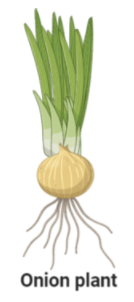
Inflorescence of onion is
A. Solitary terminal
B. Umbellate cyme
C. Raceme
D. Solitary axillary
Answer
564.3k+ views
Hint: There are five types of inflorescence (arrangement of flower): solitary, racemose, cymose, mixed, and special. The onion plant (Allium cepa), belongs to the family Alliaceae.
Step by step answer:
Inflorescence is referred to the arrangement of flowers on a branch or many branches. There are five types of inflorescence: solitary, racemose, cymose, mixed, and special.
In option A, solitary terminal is mentioned. It is a further subdivision of solitary inflorescence. In this type of inflorescence, single flowers are located at the tip of the main stem and the branches. An example of a plant showing solitary terminal inflorescence is poppy.
In option B, the umbellate cyme is mentioned. It is a type of mixed inflorescence. In this type of inflorescence, the central flower is subtended by umbellate branching; initially, it is dichasium which is then succeeded by monochasia. This is shown in onion plants.

In option C, Raceme is mentioned. In this type of inflorescence, the main axis or the stem continues to grow indefinitely and does not end in flowers. This means the tip of the flower does not have flowers.
In option D, solitary axillary is mentioned. It is a further subdivision of solitary inflorescence. In this type of inflorescence, single flowers grow in the axils of leaves. This type of inflorescence is found in Petunia, Garden Nasturtium, and Shoe Flower.
Hence, the correct option is option B.
Note: In mixed inflorescence, two or more types of the inflorescence are mixed up to form a mixed inflorescence. Common examples of this are oat, rice, wheat, umbel of capitula, grapevine, and male cannabis.
Step by step answer:
Inflorescence is referred to the arrangement of flowers on a branch or many branches. There are five types of inflorescence: solitary, racemose, cymose, mixed, and special.
In option A, solitary terminal is mentioned. It is a further subdivision of solitary inflorescence. In this type of inflorescence, single flowers are located at the tip of the main stem and the branches. An example of a plant showing solitary terminal inflorescence is poppy.
In option B, the umbellate cyme is mentioned. It is a type of mixed inflorescence. In this type of inflorescence, the central flower is subtended by umbellate branching; initially, it is dichasium which is then succeeded by monochasia. This is shown in onion plants.

In option C, Raceme is mentioned. In this type of inflorescence, the main axis or the stem continues to grow indefinitely and does not end in flowers. This means the tip of the flower does not have flowers.
In option D, solitary axillary is mentioned. It is a further subdivision of solitary inflorescence. In this type of inflorescence, single flowers grow in the axils of leaves. This type of inflorescence is found in Petunia, Garden Nasturtium, and Shoe Flower.
Hence, the correct option is option B.
Note: In mixed inflorescence, two or more types of the inflorescence are mixed up to form a mixed inflorescence. Common examples of this are oat, rice, wheat, umbel of capitula, grapevine, and male cannabis.
Recently Updated Pages
Master Class 11 Social Science: Engaging Questions & Answers for Success

Master Class 11 Physics: Engaging Questions & Answers for Success

Master Class 11 Maths: Engaging Questions & Answers for Success

Master Class 11 Economics: Engaging Questions & Answers for Success

Master Class 11 Computer Science: Engaging Questions & Answers for Success

Master Class 11 Chemistry: Engaging Questions & Answers for Success

Trending doubts
What is meant by exothermic and endothermic reactions class 11 chemistry CBSE

10 examples of friction in our daily life

Difference Between Prokaryotic Cells and Eukaryotic Cells

1 Quintal is equal to a 110 kg b 10 kg c 100kg d 1000 class 11 physics CBSE

One Metric ton is equal to kg A 10000 B 1000 C 100 class 11 physics CBSE

Draw a diagram of nephron and explain its structur class 11 biology CBSE




